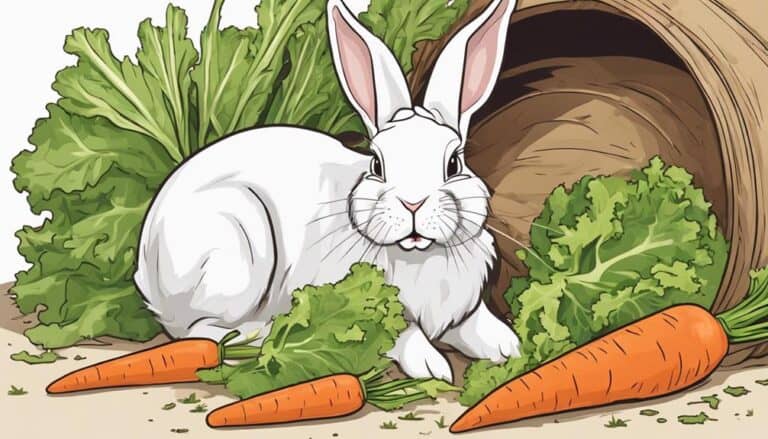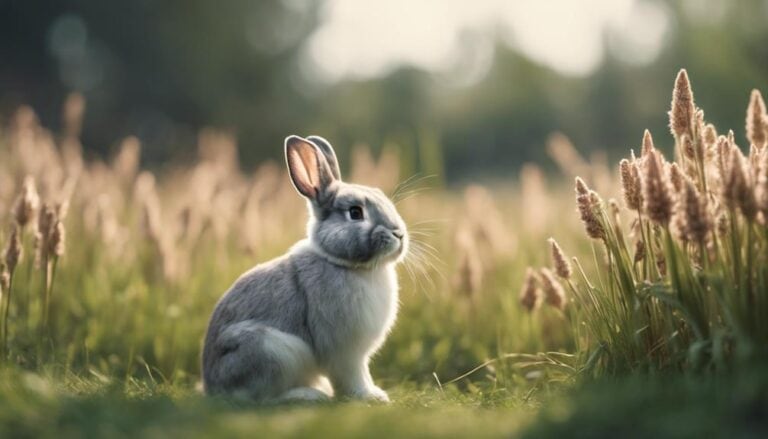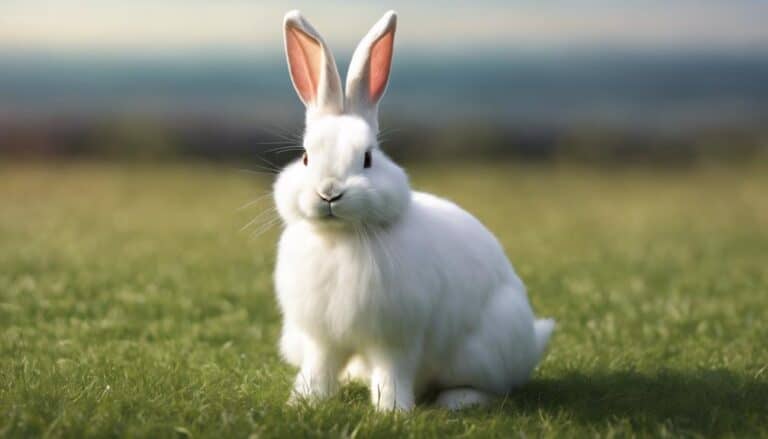So, the truth is, it's really hard to predict how many rabbits in a wild litter actually make it.
There are just too many factors at play, like predation, disease, and environmental conditions. These all have a big impact on how many rabbits survive.
On average, the number of rabbits that make it through these challenges is all over the map.
It's a pretty fascinating topic to dig into, though. By understanding how wild rabbits survive, we can learn more about the balance of nature and how these animals adapt to keep their species going.
Contents
- 1 Key Takeaways
- 2 Rabbit Litter Size
- 3 Wild Rabbit Mortality Rate
- 4 Survival Rate of Young Rabbits
- 5 Factors Affecting Rabbit Survival
- 6 Female Rabbit Reproduction Rate
- 7 Impact of Predators on Rabbit Survival
- 8 Rabbit Litter Variability
- 9 Rabbit Litter Management
- 10 Rabbit Population Dynamics
- 11 Sustainable Rabbit Survival Strategies
- 12 Conclusion
Key Takeaways
So, how many rabbits in a wild litter typically make it? Well, the sad truth is that most of them don't survive for long. On average, only about 20-25% of wild rabbit babies make it to their first birthday.
The mortality rates are actually pretty high, especially during the first month of life. Many don't make it past that point. There are several reasons for this, including predation, disease, and environmental conditions.
But it's not all doom and gloom. If the mothers take good care of their babies, and they get the right nutrition and protection from predators, more of them are likely to survive. It's also important to keep an eye on the health of the litter and provide safe nesting sites to improve their chances.
So, while the survival rate might seem low, there are things that can be done to increase it. By providing the right conditions and care, more wild rabbits can make it to adulthood.
Rabbit Litter Size
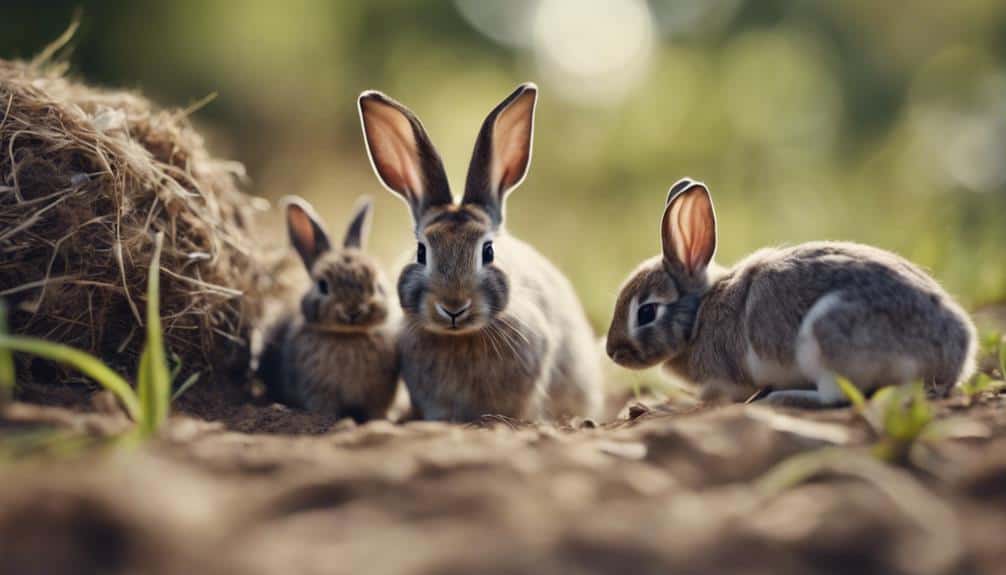
Typically, you can expect to see between 4 to 12 little rabbits in a litter in the wild, but it can vary depending on the species.
One advantage of having a larger litter is that it offers more protection through something called 'predator satiation.' This is when there are so many babies that predators can't catch them all, giving each individual a better chance of survival. On the other hand, a smaller litter might mean that the mom can take better care of each baby, increasing their chances of making it.
In the wild, mom rabbits usually have multiple litters each year – typically between 3 to 7 litters. This is because a lot of baby rabbits don't make it, so the mom needs to have a lot of litters to increase the chances of passing on her genes to the next generation.
This reproductive strategy is really important for the survival of wild rabbit populations. It helps ensure that the species continues to thrive in its natural habitat.
Wild Rabbit Mortality Rate
Wild rabbits have a tough time surviving. In fact, about 44% of them don't make it past their first month. There are a lot of reasons why this happens, like predation, disease, and bad environmental conditions.
Despite all these challenges, the rabbit population manages to stay in check. This is because many rabbits don't live past a year, which means they don't get the chance to have babies and help the population grow. As a result, the population size stays relatively stable.
Survival in the Wild
Young cottontail rabbits face a tough reality in the wild. Their mortality rate is super high – around 44% of them don't make it past their first month of life.
This harsh environment is reflected in the data, which shows that only 20-25% of rabbits survive for a year after birth.
This highlights just how precarious their existence is in the wild.
Many rabbits never get the chance to reproduce because of these high mortality rates.
This plays a crucial role in regulating the population dynamics.
The constant cycle of rapid breeding and significant mortality rates creates a delicate balance within the rabbit community.
This balance, in turn, shapes the demographics of the population at any given time.
In short, the struggle for survival in the wild is a harsh reality for young cottontail rabbits.
The high mortality rates underscore the challenging environment these rabbits must navigate.
The delicate balance between breeding and death shapes the population dynamics of wild rabbits.
Factors Affecting Mortality
Wild rabbits face a tough life, and their mortality rates are incredibly high. In fact, about 44% of cottontail rabbits don't make it past their first month. This trend continues throughout their lives, with only 20-25% surviving past their first year. It's a struggle for them to survive, and many don't live long enough to have babies of their own. This helps keep the population in check and prevents overpopulation.
One reason for these high mortality rates is predation. Rabbits have a lot of natural predators, and it's hard for them to avoid being someone else's lunch.
Disease is another major factor. Rabbits are susceptible to various illnesses, and these can spread quickly through a population.
Environmental conditions also play a role. Harsh weather, like extreme temperatures or drought, can be deadly for rabbits.
And then there are human activities, like hunting and habitat destruction, which can be major threats to rabbit populations.
All these factors combine to create a challenging environment for rabbits, where mortality is always lurking.
Natural Population Regulation
Wild rabbit mortality rates are a crucial part of natural population regulation. These mortality rates play a vital role in keeping rabbit populations in balance.
When it comes to maintaining a stable population size, mortality rates are key. If there were no natural checks on population growth, rabbit numbers would quickly get out of control. The high mortality rates among young rabbits, in particular, help keep the population in check. This is especially important in the early stages of life, when rabbit numbers could otherwise explode.
By keeping population sizes in check, mortality rates also help ensure that available resources aren't overused. This leads to a more sustainable ecosystem, where rabbits and other species can coexist without depleting their environment.
These factors highlight the complex relationship between litter sizes, mortality rates, and overall population dynamics in wild rabbit communities. By understanding how mortality affects rabbit populations, we gain insight into the delicate balance of the natural world.
Survival Rate of Young Rabbits
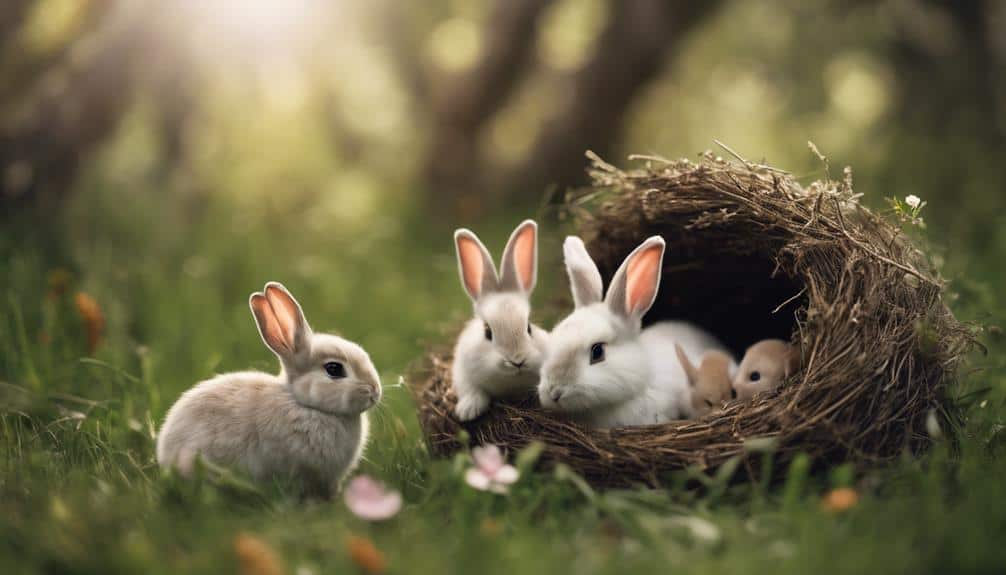
The chances of young rabbits making it past their first month are pretty slim, with only about 56% surviving. This means that a whopping 44% don't make it through this critical period. Unfortunately, things don't get much better from there – only around 20-25% of young rabbits will survive their first year.
This high mortality rate has a huge impact on the population as a whole. It's actually a good thing that so many rabbits don't make it, or the population would quickly get out of control. The constant threat of death helps keep the population in check. If rabbits did survive to reproductive age more often, they'd be able to breed rapidly and the population would grow exponentially.
When rabbits do manage to survive to reproductive age, their mortality rate drops significantly. This is why it's so important to understand the mortality rates of young rabbits. They play a vital role in regulating the population and keeping it balanced.
| Young Rabbits | Survival Rate | Mortality Rate |
|---|---|---|
| First Month | 56% | 44% |
| Yearly | 20-25% | 75-80% |
| Reproductive Age | High | Low |
Factors Affecting Rabbit Survival
Rabbit survival is heavily influenced by their high mortality rates, especially in the first month of life. This critical period has a significant impact on their overall population growth and reproductive potential.
Baby rabbits, especially cottontail rabbits, face incredibly high mortality rates. In fact, around 44% don't make it past their first month. This means many rabbits don't get the chance to reproduce and contribute to the population, which can lead to declines in numbers.
The constant cycle of rapid breeding and high mortality rates keeps the rabbit population in a delicate balance. At any given time, most of the population is typically younger than a year old.
Understanding the complex relationship between mortality rates, rabbit survival, and reproductive potential is crucial for conservation efforts and wildlife management strategies. By grasping this relationship, we can develop effective strategies to sustain healthy rabbit populations in the wild.
Female Rabbit Reproduction Rate
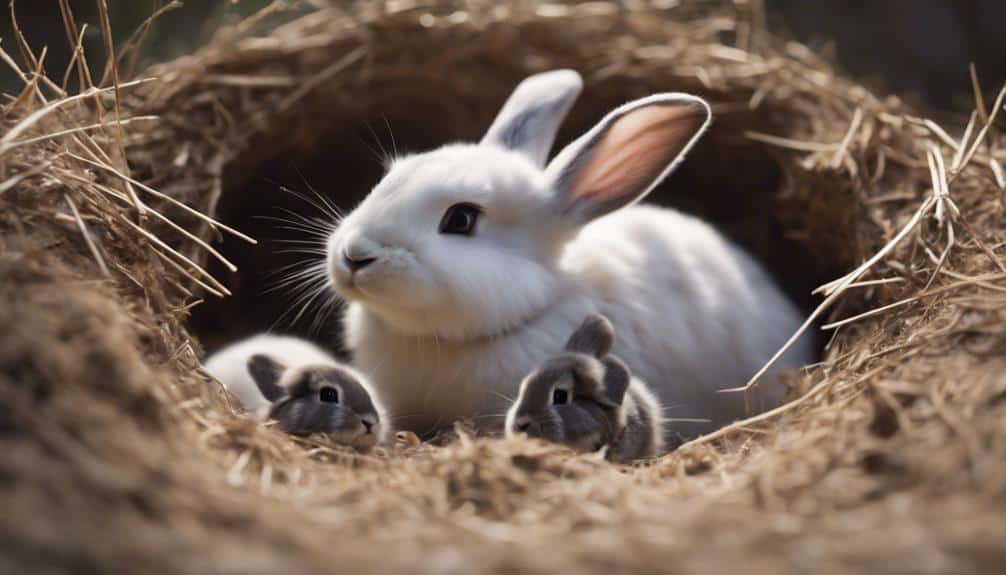
Female rabbits are incredibly prolific breeders. Each litter usually has between one and 14 babies, with an average of six. This means female rabbits play a huge role in growing the population. Plus, they can get pregnant again right after giving birth.
The reason they can breed so quickly is that their gestation period is only 28-31 days. This means they can have up to five or six litters per year in warmer areas. This high reproductive rate is a big reason why there are so many rabbits in the wild.
In ideal conditions, a pair of cottontails can produce around 18 young during the breeding season. This remarkable ability to reproduce ensures that rabbit populations stay strong and can recover from predators. Female rabbits are extremely fertile and adaptable, which helps them thrive in different environments.
Impact of Predators on Rabbit Survival
Predators like coyotes, foxes, and hawks have a huge impact on how many cottontail rabbits survive. These predators play a big role in shaping the rabbit population.
The mortality rate for baby rabbits is really high – around 44% of them don't make it through their first month. And it's not just when they're young; predation is a big deal for rabbits their whole lives.
In fact, only about 20-25% of rabbits make it to their first birthday. Because so many rabbits die before they can have babies, the population doesn't grow as quickly as it could.
But this is actually a good thing. If there were no predators, the rabbit population would grow way too fast and there wouldn't be enough food for everyone.
So, predators help keep the population in balance. And even though a lot of rabbits die, they can still have a lot of babies.
This means the rabbit population can keep going, even with all the predators around. It's a delicate balance, but it's what keeps the ecosystem healthy.
Rabbit Litter Variability
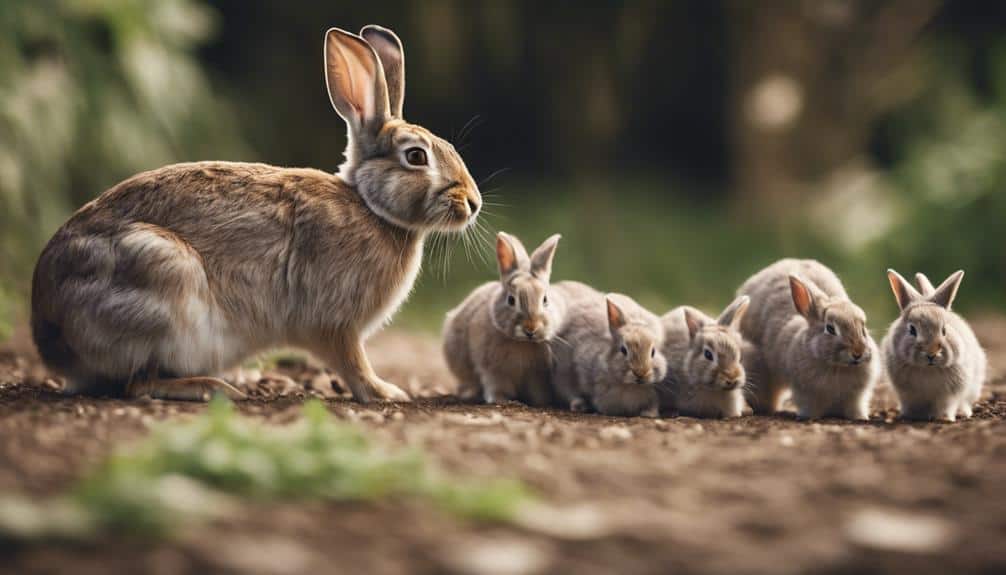
Wild rabbit populations are heavily influenced by the varying survival rates of their litters. You see, rabbit litters can have a wide range of surviving babies due to mortality rates and other factors. On average, a litter has four to five babies, but the number of survivors can vary greatly.
Factors like predation, disease, and environmental conditions all contribute to this variability in wild litters. For example, take a look at the table below, which shows the surviving rabbit variability in wild litters:
| Number of Surviving Rabbits | Percentage of Litters |
|---|---|
| 0-1 | 30% |
| 2-3 | 40% |
| 4-5 | 20% |
| 6+ | 10% |
This data really drives home the unpredictability of rabbit litter survival rates and the challenges wild rabbit populations face in maintaining stable numbers. It's crucial to understand this variability for effective conservation efforts and wildlife management strategies.
Rabbit Litter Management
Rabbit litter management is crucial for the survival and stability of wild rabbit populations. The care a mother rabbit provides, along with the environmental conditions during the early stages of a litter's life, greatly affects the mortality rates of young rabbits in the wild.
When a mother rabbit is well-fed during pregnancy and lactation, her babies are more likely to be healthy and survive. This is because good nutrition gives them a strong start in life.
It's also essential to protect the litter from predators. One way to do this is by creating safe nesting sites and minimizing disturbances. This helps keep vulnerable young rabbits safe, giving them a better chance of survival.
Regularly monitoring the litter's health and development is vital too. By checking on them frequently, you can identify any issues early on and take action to improve their survival rates. This is especially important, as it can make all the difference in the world.
Rabbit Population Dynamics
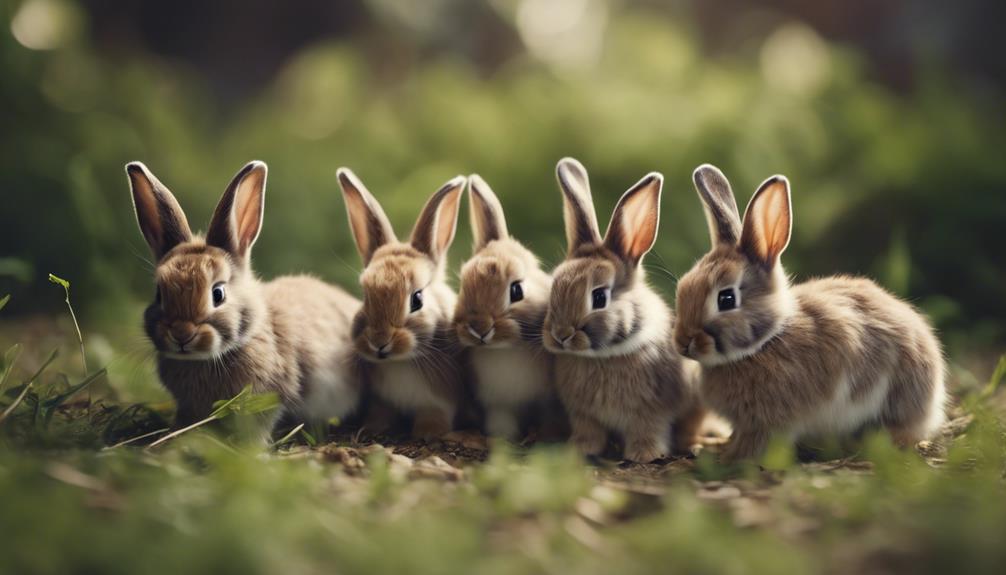
Rabbit populations are heavily influenced by the survival rates of young rabbits in the wild. The fact that only 20-25% of rabbits make it to their first birthday is crucial in keeping rabbit populations in balance. It's especially tough for cottontail rabbits, with almost half of them dying within the first month of life.
This highlights just how important it's for young rabbits to survive those early days.
One reason rabbit populations stay in check is that many rabbits don't live long enough to have babies of their own. This high mortality rate acts as a natural brake on population growth.
As a result, most cottontail rabbits you'll find are less than a year old.
If rabbits do manage to survive and have litters, their population can grow rapidly.
Sustainable Rabbit Survival Strategies
When we observe wild rabbit populations, it’s clear that we need to implement sustainable survival strategies to keep them thriving and healthy. In the wild, rabbits scatter far and wide, which means they face a lot of challenges that can be deadly, especially for the young ones. To ensure their continued existence, we must focus on implementing effective bunny survival strategies in nature, including safeguarding their habitats and providing ample food sources. Additionally, understanding their natural behaviors and social structures can help us create environments that minimize threats from predators and environmental changes. By prioritizing these strategies, we can foster resilient rabbit populations that are capable of thriving in the wild.
To ensure these delicate creatures survive, we need to put some sustainable strategies in place. For instance, protecting rabbit fur from predators is crucial for their survival. Rabbits need safe habitats to live in, so managing these areas is necessary for their long-term sustainability.
It's also essential that we reduce human-induced threats, such as habitat destruction and pollution, which harm wild rabbits. By taking these steps, we can help wild rabbits thrive and maintain a healthy balance in their populations.
Conclusion
So, how many rabbits in a wild litter actually make it? Well, the truth is, not many.
The mortality rate for baby rabbits in the wild is super high. There are just so many dangers out there, like predators and diseases, that it's a miracle any of them survive at all.
Think about it – a mom rabbit is left to care for her tiny litter, knowing that only a few of them will actually make it to adulthood.
It's a tough life, and it's amazing these little guys can even survive at all.

